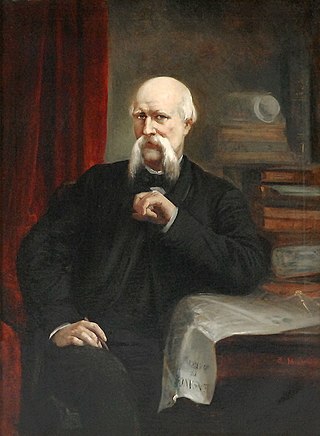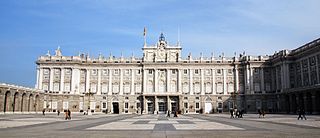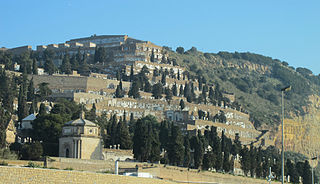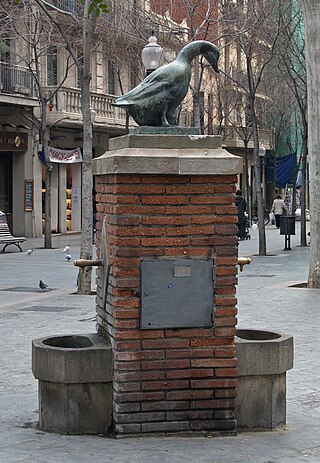
Pamplona, historically also known as Pampeluna in English, is the capital city of the Chartered Community of Navarre, in Spain.

The Eixample is a district of Barcelona between the old city and what were once surrounding small towns, constructed in the 19th and early 20th centuries. Its population was 262,000 at the last census (2005).

Ildefons Cerdà Sunyer was a Spanish urban planner and engineer who designed the 19th-century "extension" of Barcelona called the Eixample. Because of his extensive theoretical and practical work, he is considered the founder of modern town planning as a discipline, having coined the word "urbanization".

Salamanca is one of the 21 districts that form the city of Madrid, Spain. Salamanca is located to the northeast of the historical center of Madrid. Salamanca lies east of the district of Chamberí, south of Chamartín, and north of Retiro. Salamanca counts approximately 151.000 inhabitants.

Spanish architecture refers to architecture in any area of what is now Spain, and by Spanish architects worldwide. The term includes buildings which were constructed within the current borders of Spain prior to its existence as a nation, when the land was called Iberia, Hispania, or was divided between several Christian and Muslim kingdoms. Spanish architecture demonstrates great historical and geographical diversity, depending on the historical period. It developed along similar lines as other architectural styles around the Mediterranean and from Central and Northern Europe, although some Spanish constructions are unique.

Chamberí is a district of Madrid, Spain. It is further subdivided into six neighborhoods. The district junta is headquartered at the plaza de Chamberí. The current urban outline was born as part of the Ensanche plan drafted by Carlos María de Castro.

Gràcia is a district of the city of Barcelona, Spain. It comprises the neighborhoods of Vila de Gràcia, Vallcarca i els Penitents, El Coll, La Salut and Camp d'en Grassot i Gràcia Nova. Gràcia is bordered by the districts of Eixample to the south, Sarrià-Sant Gervasi to the west and Horta-Guinardó to the east. A vibrant and diverse enclave of Catalan life, Gràcia was an independent municipality for centuries before being formally annexed by Barcelona in 1897 as a part of the city's expansion.

Gran Via de les Corts Catalanes, more simply known as Gran Via, is one of Barcelona's major avenues. With a length of 13.1 km (8.1 mi), it is the longest street in Catalonia and the 2nd longest in Spain, after Gran Vía de la Manga, in La Manga del Mar Menor, but is the one with most street numbers in Spain.

Avinguda Diagonal is the name of one of Barcelona's broadest and most important avenues. It cuts the city in two, diagonally with respect to the grid pattern of the surrounding streets, hence the name.

The Illa de la Discòrdia or Mansana de la Discòrdia — "Block of Discord"; Spanish: Manzana de la Discordia — is a city block on Passeig de Gràcia in the Eixample district of Barcelona, Catalonia, Spain. The block is noted for having buildings by four of Barcelona's most important Modernista architects, Lluís Domènech i Montaner, Antoni Gaudí, Josep Puig i Cadafalch and Enric Sagnier, in close proximity. As the four architects' styles were very different, the buildings clash with each other and the neighboring buildings. They were all built in the early years of the 20th century.

Montjuïc Cemetery, known in Catalan as Cementiri del Sud-oest or Cementiri de Montjuïc, is located on one of the rocky slopes of Montjuïc hill in Barcelona.

La Nova Esquerra de l'Eixample is a neighborhood in the Eixample district of Barcelona, Catalonia (Spain). Originally it formed a single unit, called Esquerra de l'Eixample, with the current neighborhood l'Antiga Esquerra de l'Eixample.

El Camp de l'Arpa del Clot is one of the ten neighborhoods of Barcelona which compose the district of Sant Martí, Catalonia (Spain). It was annexed by Barcelona in the year 1897. It is situated in the upper part of this district and before it was named Camp de l'Arca.

The Walls of Madrid are the five successive sets of walls that surrounded the city of Madrid from the Middle Ages until the end of the 19th century. Some of the walls had a defensive or military function, while others made it easy to tax goods entering the city. Towards the end of the 19th century the demographic explosion that came with the Industrial Revolution prompted urban expansion throughout Spain. Older walls were torn down to enable the expansion of the city under the grid plan of Carlos María de Castro.

The architecture of Barcelona has undergone a parallel evolution alongside Catalan and Spanish architecture, reflecting the diverse trends found in the history of Western architecture. Throughout its historical development, Barcelona has been influenced by numerous cultures and civilizations, each contributing their artistic concepts and leaving a lasting legacy. The city's architectural heritage can be traced back to its earliest inhabitants, the Iberian settlers, followed by the Romans, Visigoths, and a brief Islamic period. In the Middle Ages, Catalan art, language, and culture flourished, with the Romanesque and Gothic periods particularly fostering artistic growth in the region.

Carlos María de Castro was a Spanish architect, engineer and urban planner. He created the plan of the urban expansion (Ensanche) of Madrid. The New Plan of Madrid was commissioned in 1857 and adopted in 1860. It was inspired by some technical aspects of Ildefons Cerdà's early studies and plans for the extension of Barcelona. But unlike Cerdà who sought to avoid social segregation, Castro proposed functional and social zoning.

The odonyms of Barcelona — meaning the street names in Barcelona along with the names of thoroughfares and other roads in the city — are regulated by the Ponència de Nomenclàtor dels Carrers de Barcelona, a commission under the Department of Culture of the Barcelona City Council.

The urban planning of Barcelona developed in accordance with the historical and territorial changes of the city, and in line with other defining factors of public space, such as architecture, urban infrastructure and the adaptation and maintenance of natural spaces, parks and gardens.
The Cerdà Plan was a plan to reform and expand the city of Barcelona created in 1860 that followed the criteria of the Hippodamus plan, with a grid structure, open and egalitarian. It was created by the civil engineer Ildefons Cerdà and its approval was followed by a strong controversy for having been imposed by the government of the Kingdom of Spain against the plan of Antonio Rovira y Trías who had won a competition of the Barcelona City Council.


















